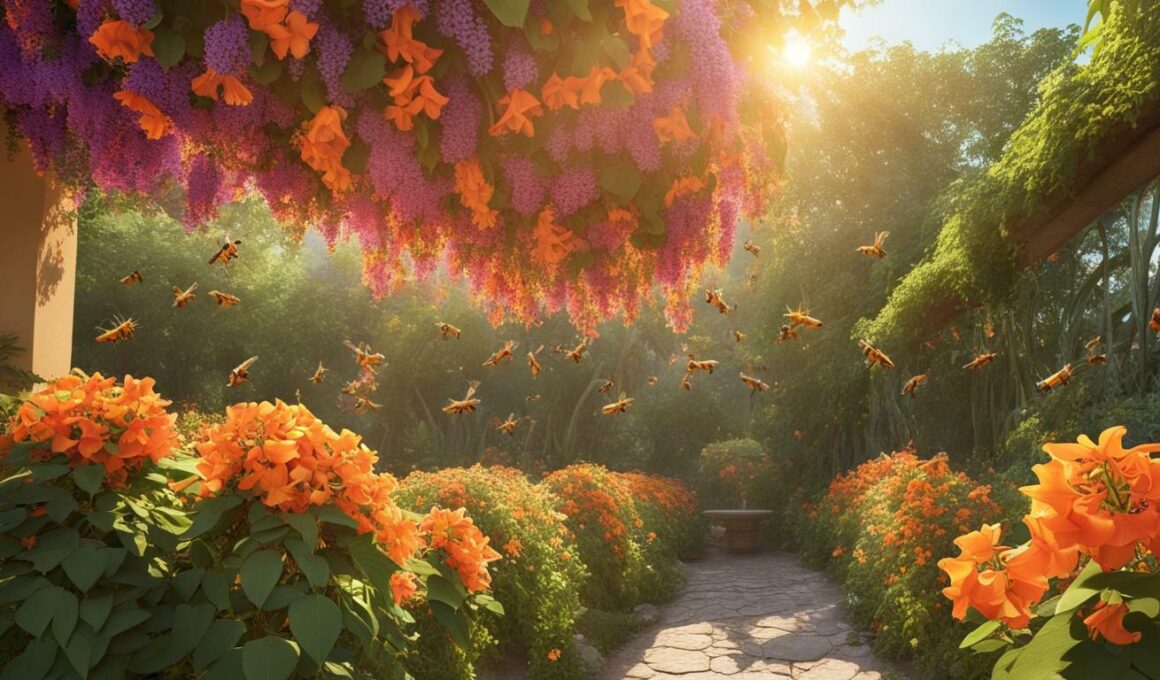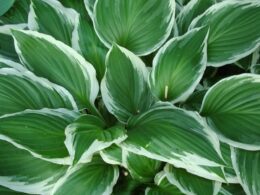Are you looking to attract more honeybees to your garden? You may be wondering if trumpet vine is a good option. These beautiful, trumpet-shaped flowers are a favorite among many pollinators, including bees. In this article, we’ll explore the relationship between honeybees and trumpet vine and how this plant can benefit both you and the bees in your garden.
Post Summary:- Honeybees are attracted to the trumpet-shaped flowers of the trumpet vine.
- Understanding honeybee behavior and foraging habits can help you better understand their interaction with trumpet vine.
- Trumpet vine can provide a valuable food source for honeybees and support their populations.
- Attracting honeybees to your garden with trumpet vine can create a thriving, bee-friendly environment.
Honeybee Behavior and Foraging Habits
Understanding honeybee behavior and foraging habits can provide valuable insights into their interactions with trumpet vine, and whether they are attracted to it. Honeybees are social insects that live in colonies of up to 60,000 individuals, with a well-defined hierarchy and division of duties. The colony includes a queen bee responsible for laying eggs, male drones whose sole purpose is to mate with the queen, and female worker bees responsible for collecting nectar and pollen, nursing the brood, and defending the colony.
Worker bees are the primary foragers of the colony, and they visit flowers in search of nectar and pollen, which are essential sources of energy, nutrients, and protein for the colony. Honeybees use their sense of smell, sight, and taste to locate and evaluate flowers, relying on color, shape, scent, and the presence of nectar guides.
The behavior of honeybees is influenced by various internal and external factors, including the time of day, temperature, humidity, wind speed, light intensity, and the abundance and quality of nectar and pollen sources. Honeybees tend to forage more during the day when the temperature is warm and the humidity is high, and they prefer to visit flowers that offer a high reward in terms of nectar and pollen.
Honeybee Behavior and Foraging Habits
In addition to their innate preferences, honeybees are also influenced by external factors such as competition with other pollinators, the presence of predators and parasites, and the availability of alternative food sources. Therefore, even though honeybees may be attracted to trumpet vine flowers, they may not exclusively visit them and may also forage on other nearby flowers.
Overall, honeybees are highly adaptable and can adjust their foraging behavior in response to changing environmental conditions and food availability. By understanding their behavior and preferences, you can create a bee-friendly garden that supports honeybee populations and enhances the natural ecosystem.
The Interaction Between Honeybees and Trumpet Vine
Trumpet vine is a favorite among honeybees for its bright, showy flowers and rich nectar content. When honeybees visit trumpet vine flowers, they use their long proboscises to extract nectar from the base of the flowers. As they do so, they inadvertently collect pollen on their bodies, which they then transfer to other flowers, helping to pollinate the plant.
Trumpet vine flowers are tubular in shape and average about 3 inches in length. They are typically bright orange or red, although there are some varieties that produce yellow or pink blooms. The flowers are also quite fragrant and emit a sweet, floral scent that is attractive to bees and other pollinators.
| Honeybee Interactions with Trumpet Vine | Benefits for Honeybees |
|---|---|
| Extract nectar using long proboscises | Rich source of nectar and pollen |
| Inadvertently collect pollen on their bodies | Contributes to pollination of trumpet vine and surrounding plants |
| Attracted to bright, fragrant flowers | Provides food and habitat for honeybees |
The interaction between honeybees and trumpet vine benefits both parties. Honeybees rely on the plant as a source of food during the summer months when nectar sources can be scarce. At the same time, honeybees play a key role in pollinating trumpet vine flowers, which is essential to the plant’s reproduction. By supporting honeybee populations, trumpet vine helps to maintain biodiversity and ensure a healthy ecosystem.
Trumpet Vine as a Food Source for Honeybees
Trumpet vine is an excellent source of nutrition for honeybees. The nectar from the trumpet vine flowers is rich in sugars, amino acids, and minerals that are vital for the survival and well-being of honeybees. The trumpet vine is also an important source of pollen for honeybees, providing them with essential vitamins and minerals.
Research has shown that honeybees are highly attracted to trumpet vine flowers, and they forage on them regularly during the summer months when the flowers bloom. This helps honeybees to build up their reserves of food and energy, which is crucial for their survival during the winter months when food sources are scarce.
| Nutritional Value of Trumpet Vine Nectar for Honeybees | ||
|---|---|---|
| Sugars | Amino Acids | Minerals |
| Fructose | Proline | Calcium |
| Glucose | Valine | Magnesium |
| Sucrose | Aspartic acid | Sodium |
The nutritional value of trumpet vine nectar for honeybees is comparable to that of other popular nectar sources, such as clover and wildflowers. The sugar content of trumpet vine nectar is particularly high, making it an important energy source for honeybees.
In addition to providing honeybees with essential nutrition, trumpet vine also plays a key role in honey production. The nectar from the trumpet vine flowers is used by honeybees to create a delicious honey with a unique flavor profile. This honey is highly prized by beekeepers and honey enthusiasts alike.
Overall, trumpet vine is an important food source for honeybees, providing them with essential nutrients and contributing to the production of high-quality honey. By cultivating trumpet vine in your garden, you can help to support honeybee populations and contribute to the health and diversity of our ecosystem.Impact of Trumpet Vine on Honeybee Population
If you’re looking to support honeybee populations in your garden, planting trumpet vine may be a great place to start. Not only do honeybees use trumpet vine as a food source, but the plant can also have a positive impact on honeybee populations and overall biodiversity.
Research has shown that trumpet vine can support honeybee survival and reproduction by providing them with an important source of nectar and pollen. As honeybees collect nectar from trumpet vine flowers, they transfer pollen, which helps to fertilize other plants in the area.
Additionally, trumpet vine can help to increase biodiversity in your garden by attracting other pollinators such as butterflies and hummingbirds.
It’s important to note, however, that while trumpet vine can benefit honeybee populations, it should be planted in moderation. Overplanting can lead to crowding and competition for resources, which can actually harm honeybee populations in the long run.
Overall, planting trumpet vine in your garden can be a great way to support honeybees and contribute to a thriving, biodiverse ecosystem.
Attracting Honeybees with Trumpet Vine in Your Garden
If you want to attract honeybees to your garden, trumpet vine is an excellent choice. Not only are its bright, trumpet-shaped flowers beautiful to look at, but they also provide a rich source of nectar for hungry bees. Here are some tips for attracting honeybees with trumpet vine in your garden:
Choose the Right Location
Trumpet vine thrives in warm, sunny locations with well-draining soil. Look for a spot in your garden that gets plenty of sunlight and has good air circulation. Avoid planting trumpet vine in areas that are prone to standing water or have poor drainage.
Plant at the Right Time
Trumpet vine can be planted in both the spring and fall. If you’re planting in the spring, wait until all danger of frost has passed and the soil begins to warm up. If you’re planting in the fall, do so at least six weeks before the first frost is expected.
Provide Support
Trumpet vine is a climbing plant that needs support to reach its full potential. Plant it near a fence, trellis, or other structure that it can climb and wrap its tendrils around. This will not only help the plant grow taller but also give the bees easy access to the flowers.
Water Regularly
While trumpet vine is drought-tolerant once established, it still needs regular watering during the first few years of growth. Water deeply once a week during the summer months to keep the soil moist and the plant healthy.
Avoid Pesticides
One of the biggest threats to honeybees is the use of pesticides in the garden. Avoid using pesticides or other chemicals that may harm the bees or their food sources. Instead, opt for natural pest control methods like handpicking or using insecticidal soap.
By following these tips, you can attract honeybees to your garden and provide them with a valuable source of food. Not only will you be helping to support the bees, but you’ll also be able to enjoy the beauty of trumpet vine in your own backyard.
Can Trumpet Vines Harm Honeybees in Arizona?
Trumpet vine invasiveness in arizona raises concerns about its impact on honeybees. While these beautiful, trumpet-shaped flowers are popular for their vibrant colors, they can spread rapidly, crowding out native plants. This could potentially affect honeybees’ foraging options, leading to a decline in their population. It is essential to carefully manage and monitor the presence of trumpet vines to prevent any negative consequences on honeybee health and the ecosystem at large in Arizona.
Trumpet Vine and Honey Production
Did you know that trumpet vine can also play a role in honey production? Honeybees utilize the nectar from trumpet vine flowers to create a delicious and unique honey.
The honey produced from trumpet vine nectar has a slightly bitter taste with a fruity undertone. This distinct flavor is due to the presence of iridoid glycosides, a compound found in trumpet vine nectar.
While trumpet vine honey is not as common as other types of honey, it is considered a prized delicacy by many beekeepers and honey enthusiasts. If you’re lucky enough to come across trumpet vine honey, give it a try!
Conclusion
Congratulations! You have learned all about the fascinating relationship between honeybees and trumpet vine. We hope you now have a better understanding of the benefits this beautiful plant can bring to your garden.
By attracting honeybees to your garden with trumpet vine, you are not only creating a safe and beautiful environment for these essential pollinators, but also supporting the wider ecosystem and contributing to biodiversity.
Don’t forget that trumpet vine can also contribute to honey production, adding to the many benefits this plant can bring to your garden. By incorporating it into your landscape, you are not only creating a beautiful and thriving environment but also helping to support honeybee populations.
Remember these key takeaways:
- Honeybees are attracted to trumpet vine because of its nectar-rich flowers
- Trumpet vine can provide a valuable food source for honeybees and contribute to their overall diet
- Trumpet vine is important for supporting honeybee populations and contributing to biodiversity
- You can attract honeybees to your garden with trumpet vine and create a thriving, bee-friendly oasis
- Trumpet vine can also contribute to honey production
So go out there and start planting your own trumpet vine! Your garden will thank you, and so will the honeybees.
Can Honeybees Also Use Crossvine for Pollination?
Yes, honeybees can also use Crossvine for pollination. Crossvine vs trumpet vine, Crossvine’s tubular flowers are a food source for bees and other pollinators. Its nectar and pollen-rich flowers make it a valuable plant for supporting honeybee populations.
FAQ
Q: Do honeybees use trumpet vine as a food source?
A: Yes, honeybees are attracted to trumpet vine and use it as a food source.
Q: How does trumpet vine benefit honeybees and my garden?
A: Trumpet vine provides a nectar-rich food source for honeybees, attracting them to your garden and supporting their populations.
Q: What are honeybee behavior and foraging habits?
A: Honeybees have specific behavior patterns and foraging habits, including searching for nectar-rich flowers like trumpet vine.
Q: How do honeybees interact with trumpet vine?
A: Honeybees interact with trumpet vine by pollinating its flowers, helping in the plant’s reproduction and spreading its genetic material.
Q: Is trumpet vine a nutritious food source for honeybees?
A: Yes, trumpet vine provides honeybees with important nutrients that contribute to their overall diet and honey production.
Q: What impact does trumpet vine have on honeybee populations?
A: Trumpet vine can support honeybee populations by providing a reliable food source and contributing to biodiversity in your garden.
Q: How can I attract honeybees to my garden with trumpet vine?
A: Planting trumpet vine in your garden can attract honeybees, creating a bee-friendly environment and supporting their well-being.
Q: Does trumpet vine contribute to honey production?
A: Yes, honeybees collect nectar from trumpet vine flowers to create delicious honey.









